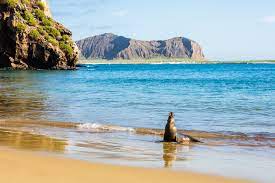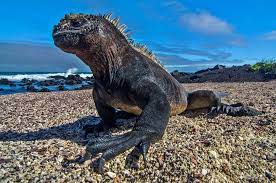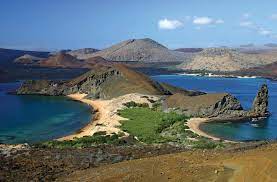The Galápagos Islands, located in the Pacific Ocean off the coast of Ecuador, approximately 620 miles off the coast of Ecuador, lies a natural wonder unlike any other – the Galápagos Islands. Famous for their remarkable biodiversity and unique ecosystems, these volcanic islands have captivated explorers, scientists, and travelers for centuries. are renowned for their unique and diverse.
A GLIMPSE
There is a total of 21 islands with 18 of them considered significant. The total Galapagos Islands measures square miles (7,995.4 sq km) and spread across 17,000 square miles (45,000 sq km) of ocean waters.
Galapagos National Park is a UNESCO World Heritage Site and the country’s first national park.
The highest point in the Galapagos Islands occurs at Volcán Wolf on Isabela Island and it reaches a height of 5,600 feet (1,707 m).
Isabela Island is the largest island and accounts for the majority of land area in the Galapagos. The Ecuadorian government has declared 97% of the Galapagos Island area as a protected area through the Galapagos National Park.
Along with Isabela, Baltra, Floreana, San Cristobal, and Santa Cruz are the populated islands and account for about 3% of the total Galapagos Island area.
The wildlife in the Galapagos Islands is globally renowned featuring the Galapagos land iguanas, the marine iguanas, and the giant Galapagos tortoise. The marine iguanas of the national park are the only ones that swim and eat from the sea.
Other popular species include the green turtle, blue-footed booby, waved albatross, and the Galapagos hawk and Galapagos penguin.
Sea lions, whale sharks, hammerhead sharks, and several other marine species await divers and snorkelers.
Endemic mockingbirds, finches, and tanagers are special treats for visitors as well.
Sustainable tourism practices have thus become crucial in ensuring the long-term preservation of this natural treasure.
Click here to get more tips: https://www.youtube.com/watch?v=xS6Bn5RKCb8
Today, the Galápagos serves as a living laboratory for scientists and a popular destination for eco-tourists seeking to explore
its remarkable wildlife and pristine landscapes.
A Natural Laboratory
The Galápagos Islands, consisting of 13 main islands and numerous smaller islets, are often referred to as a “living laboratory of evolution.” The isolation of the islands, combined with their diverse habitats, has led to the evolution of distinct species found nowhere else on Earth.
The Galápagos Islands, renowned for their unparalleled biodiversity and unique ecosystems, have become a hotspot for tourism in recent years. However, the influx of visitors also poses challenges to the fragile environment of the islands. From the iconic giant tortoises and marine iguanas to the colorful blue-footed boobies and Galápagos penguins, the islands are home to an astonishing array of wildlife.
A Diverse Marine Wonderland
Beneath the crystal-clear waters surrounding the Galápagos Islands lies another world teeming with life. The marine ecosystem
here is equally as diverse as the terrestrial one, with an abundance of marine species ranging from playful sea lions and graceful
manta rays to elusive hammerhead sharks and majestic whale sharks. Snorkeling and diving in these waters offer unparalleled
opportunities to witness this underwater paradise up close.
Exploring the Islands
Visitors to the Galápagos Islands have the chance to explore the various islands and their unique landscapes. Whether hiking through rugged lava fields, kayaking along pristine coastlines, or lounging on picturesque beaches, there is no shortage of activities to experience.
Each island offers its own distinct scenery and wildlife, providing endless opportunities for adventure and discovery.
Tourism in the Galápagos Islands provides vital economic opportunities for local communities and contributes to the conservation
efforts on the islands. Revenue generated from tourism helps fund conservation projects, supports local businesses, and provides employment opportunities for residents.
Additionally, tourism offers visitors the chance to experience the natural beauty and wildlife of the islands firsthand, fostering a deeper appreciation for conservation efforts worldwide.
Despite its benefits, tourism in the Galápagos Islands also presents significant challenges. The increasing number of visitors
can place strain on the delicate ecosystems, leading to habitat destruction, pollution, and disruption of wildlife.
Invasive species introduced by tourists can also threaten native flora and fauna, further exacerbating conservation concerns.


Conservation and Sustainability
With such remarkable biodiversity comes the responsibility to protect and preserve these fragile ecosystems.
Conservation efforts in the Galápagos Islands are ongoing, with strict regulations in place to minimize the impact of tourism
and human activity on the environment. Sustainable tourism practices are encouraged, ensuring that future generations
will have the opportunity to experience the wonders of the Galápagos.
Engaging local communities in sustainable tourism initiatives is essential for the long-term success of conservation efforts
in the Galápagos Islands. Community-based tourism projects empower residents to take an active role in managing tourism activities,
while also providing economic incentives to protect the environment. By involving local communities in decision-making processes and supporting small-scale enterprises, tourism can become a force for positive change in the islands.
The Galápagos Islands are a testament to the beauty and resilience of nature. From their diverse wildlife to their stunning landscapes,
these islands continue to inspire awe and wonder in all who visit them. Whether you’re an avid nature enthusiast, an adventurous traveler,
or simply someone seeking a deeper connection with the natural world, the Galápagos Islands offer an unforgettable experience unlike any other.
Sustainable tourism plays a vital role in balancing the conservation of the Galápagos Islands’ unique ecosystems with the
economic benefits of tourism. By promoting responsible travel practices, supporting local communities, and engaging
visitors in conservation efforts, we can ensure that future generations will continue to marvel at the wonders of the
Galápagos for years to come.
Read Also: https://placesandlifestyle.com/the-taj-mahal-symbol-of-love/




